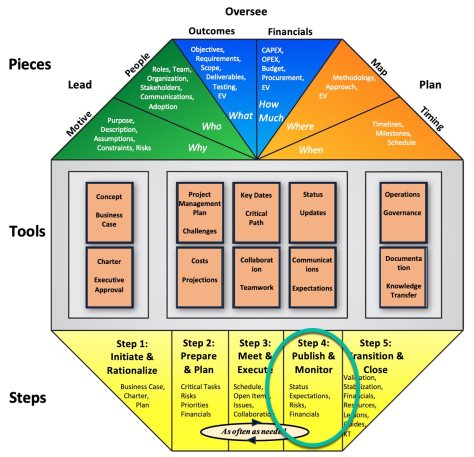Step 3 to Project Success
This article covers Step 4 for project success and it is about ensuring you have clear communications and tracking to get daily priorities completed in order to finish on time.
Publish and Monitor
There are five steps to a project, with the middle three repeated each week, or as needed, and it’s the third of those three, and the fourth step overall that we’re covering.

Step 4 of project success
Step 4: Publish and Monitor – Concepts
So many times you make the assumption that everyone who has been in the meetings, participated, and nodded to what needs to get done today, tomorrow, and by the same time next week comes away with the same message.
Things were discussed. Everything was covered and clear, right?
But then later you find them working on other priorities that were not discussed and are not critical right now, and they don’t get those items done that day, or that week and then ask for more time. So, your project begins to slip. And that’s how it happens.
The completion of a team discussion about what is critical reminds me of the telephone game, where participants sit in a circle facing each other and the starter person whispers a sentence in the ear of the person to their left who whispers what they heard to the person to their left and so on around the circle until the single sentence message arrives back to the starter.
Just like the instructions to a team, it’s always surprising what comes back because often it doesn’t resemble at all what was initially said; or worse, conveys an action that is entirely different than what should have been conveyed.
Wearing the project leader hat, you’re the starter person, and of course what’s critical is obvious to you, because you spend more time thinking about it than everyone else.
But everyone else has many other urgent and critical priorities that have nothing to do with you or your project, and you’re just one of their priorities, and maybe even not the highest one.
Never assume that your team and stakeholders know what is due today, tomorrow, and next week based on a verbal discussion.
That’s why you need to publish, or somehow communicate to allow review and contemplation by the team, the outcomes expected today, tomorrow, and over the next few days. And then create an easy-to-consume way to review if those outcomes are getting done or not and to what extent?
Having written published, simple itemizations of what needs to get done allows you to have productive follow-up discussions when you’re monitoring to understand how things are getting done.
Step 4: Publish and Monitor - Details
Below are some details around publishing and monitoring to get you started. Create a base status to use for both the steering team (the senior team that helps support and make decisions about $’s, schedule, and scope), and also the project team (the ones that are getting the project deliverables done). Details are next.
- Accomplishments. Recognize what got done but keep at a team level without mentioning individual names because that’s a slippery slope and if you start mentioning names, you’ll spend too much time thereafter on making sure everyone is mentioned, and if there were two doing something, include both names; and what happens if you forget someone, because they will look for their names, and, well, you get the picture. Keep it at a team level.
Share specific details with the team, but you can summarize a bit to match the steering strategies and goals. - Planned. What has to get done today, tomorrow, and each day over the next week. Create a clear and easy to follow, jargon-less checklist.
TIP: Get the team members to describe what they are going to get done in their own words.
- Risks. Use the risk frameworks in the Learning Hub. Keep it to the top few most critical ones. Don’t list them all each week, just the ones that may be impacting.
TIP: Share the risks and the exact wording that the Steering team will see with your project team so they understand the relevance and can frame the criticality.
- Financials. Just for the steering team. Paste in your current CAPEX and OPEX. See more financial details in the Learning Hub.
- Schedule. This is really key. Abstract and show at a high level the relationship between what has to get done right now and how it relates to the end schedule of the project.
I say “abstract” because you may need to create a manual, simplified Gantt chart, and such as in Word, or Excel, or whatever document creation and spreadsheet tool you have, to get rid of the clutter that a tool will deliver.
TIP: It has to be painstakingly clear that if the items planned today, tomorrow, and next week don’t get done, the project is slipping. If you can do this, it’s amazing how creative juices start flowing to find other ways to get things done to keep the schedule on track.
- Publish. Send it out right away. Don’t delay. Send to the project team. Send as necessary to the Steering team. Make sure everyone knows what has to get done today, tomorrow, and over the next week to keep the project on track. And identify what is blocking it and needs creative resolution.
Summary
In conclusion, some status templates add way too much detail and too much information and then NO ONE reads them.
Bottom line is that you need your team and steering to understand and be motivated to get the most important thing done today, tomorrow, and each day over the next week, or your project is going to slide.
Understanding and following the list of what has to get done is a very important point, and it is relevant for waterfall, hybrid, and agile.
Make sure your communications about these critical items are clear, and the items are measurable so you can monitor whether they are getting done or not.
Action Steps / Apply This Knowledge
- Create a draft template to use each week. KISS.
- Create it before you meet with the team and it will guide you as you discuss with the project members and other stakeholders, like the Steering team.
- Prompt engineering guidance for GPTs such as chatGPT: I’m a business leader managing a project which is delivering X, in Y timeframe, with Z dollars. What are some current risks I need to be aware of to communicate to my project team or Steering Committee?”
Learn More to Do More
Quick access to steps that help: https://simplepmstrategies.com/learning-hub-index
Step 4 to Project Success: Publish and Monitor
© Simple PM Strategies 2024
